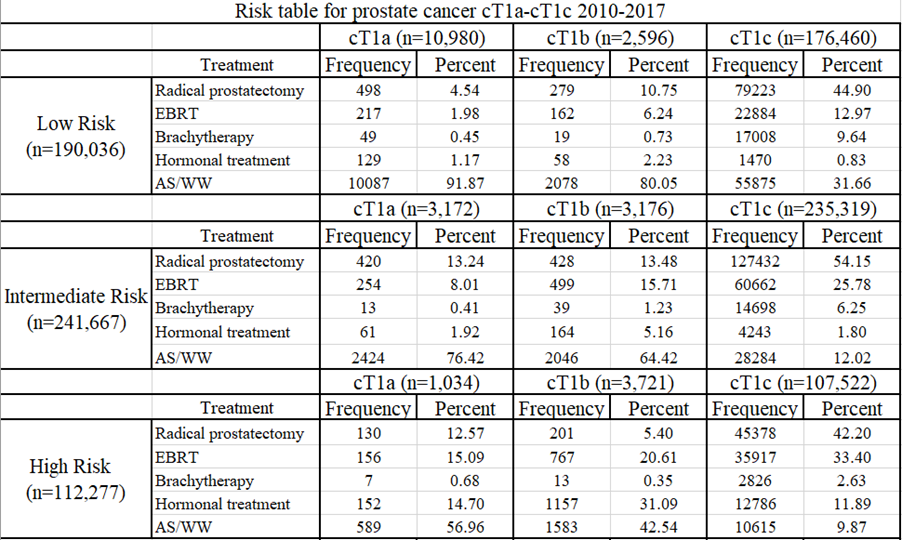Back
Poster, Podium & Video Sessions
Podium
PD13: Prostate Cancer: Epidemiology & Natural History II
PD13-04: Trends in Diagnosis and Treatment of T1a, T1b Prostate Cancer in the United States, 2010-2017.
Friday, May 13, 2022
4:00 PM – 4:10 PM
Location: Room 252
Eyal Kord*, Hannah Koenig, On Ho, John Paul Flores, Christopher Porter, Seattle, WA

Eyal Kord, MD,MPH
Virginia Mason Medical center
Podium Presenter(s)
Introduction: Currently, there is no consensus regarding optimal treatment for incidental prostate cancer (PCa) finding after surgical treatment for benign prostate obstruction. In addition, changing recommendations regarding PCa screening in the US during the last decade, have led to changes in incidence patterns of PCa. We aimed to assess recent trends in diagnosis and treatment of T1a, T1b PCa in the US.
Methods: Using the National Cancer Database, we identified patients diagnosed with T1a, T1b, and T1c PCa between 2010-2017. We described rates of diagnosis, change in clinically significant disease, and patients risk stratification over the time-period studied. Use of treatment modalities was compared between the risk stratified groups. We used the two-way ANOVA and Tukey post Hoc Tests to examine significant changes in incidence and treatment.
Results: We identified 24,679 patients diagnosed with T1a (15,186) or T1b (9,493) PCa between 2010-2017. Newly diagnosed T1a/b cases represented an average of 3.54% of all PCa cases without a significant change in incidence over the years. The chance of T1a/b being clinically significant (CS) increased steadily and significantly over time representing 38.7% in 2010 and 44.1% in 2017 (p < 0.001). Low, intermediate, and high-risk disease comprised 72.3%,20.9%, and 6.8% of T1a, and 27.3%,33.5%, and 39.2% of T1b diagnosis, respectively. In comparison to T1c, patients diagnosed with T1a/b disease were older (62.2 Vs 70.3 for Low, 64.4 Vs 72.3 for intermediate, and 67.1 Vs 76.4 for high risk, p<0.001) and had a higher comorbidity score across all risk groups. (0.18 Vs 0.42 for Low, 0.23 Vs 0.46 for intermediate, and 0.27 Vs 0.45 for high risk, p<0.001) Across all risk groups, patients diagnosed with T1a/b disease were significantly less likely to be treated definitively with surgery or radiation, and more likely to be treated with active surveillance/watchful waiting or androgen deprivation therapy in comparison to T1c patients. (Table 1)
Conclusions: Although the incidence of T1a/b PCa remained stable, the chance of CS disease diagnosis increased between 2010-2017. In comparison to T1c, men diagnosed incidentally with T1a/b disease are less likely to receive definitive treatment by surgery or radiation.
Source of Funding: None

Methods: Using the National Cancer Database, we identified patients diagnosed with T1a, T1b, and T1c PCa between 2010-2017. We described rates of diagnosis, change in clinically significant disease, and patients risk stratification over the time-period studied. Use of treatment modalities was compared between the risk stratified groups. We used the two-way ANOVA and Tukey post Hoc Tests to examine significant changes in incidence and treatment.
Results: We identified 24,679 patients diagnosed with T1a (15,186) or T1b (9,493) PCa between 2010-2017. Newly diagnosed T1a/b cases represented an average of 3.54% of all PCa cases without a significant change in incidence over the years. The chance of T1a/b being clinically significant (CS) increased steadily and significantly over time representing 38.7% in 2010 and 44.1% in 2017 (p < 0.001). Low, intermediate, and high-risk disease comprised 72.3%,20.9%, and 6.8% of T1a, and 27.3%,33.5%, and 39.2% of T1b diagnosis, respectively. In comparison to T1c, patients diagnosed with T1a/b disease were older (62.2 Vs 70.3 for Low, 64.4 Vs 72.3 for intermediate, and 67.1 Vs 76.4 for high risk, p<0.001) and had a higher comorbidity score across all risk groups. (0.18 Vs 0.42 for Low, 0.23 Vs 0.46 for intermediate, and 0.27 Vs 0.45 for high risk, p<0.001) Across all risk groups, patients diagnosed with T1a/b disease were significantly less likely to be treated definitively with surgery or radiation, and more likely to be treated with active surveillance/watchful waiting or androgen deprivation therapy in comparison to T1c patients. (Table 1)
Conclusions: Although the incidence of T1a/b PCa remained stable, the chance of CS disease diagnosis increased between 2010-2017. In comparison to T1c, men diagnosed incidentally with T1a/b disease are less likely to receive definitive treatment by surgery or radiation.
Source of Funding: None


.jpg)
.jpg)